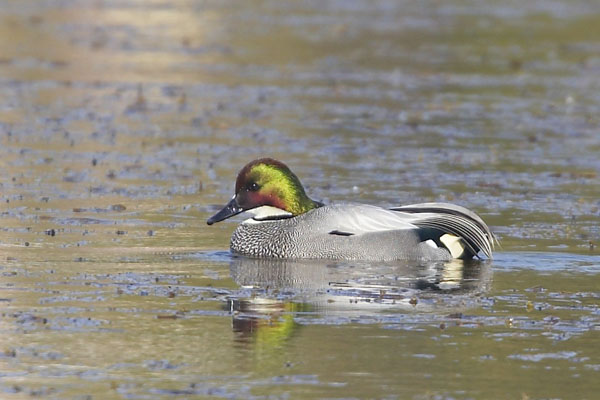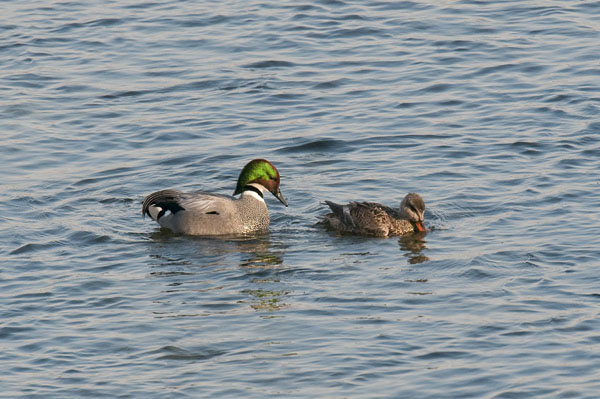Anas falcata
IUCN
LCBasic Information
Scientific classification
- name:Anas falcata
- Scientific Name:Lapwing, Sickle duck, Flathead duck, early duck, three duck, Sickle feather duck,Anas falcata,Falcated Teal,Falcated Duck
- Outline:Waterfowl
- Family:Anseriformes Anseriidae
Vital signs
- length:40-52cm
- Weight:0.4-1kg
- lifetime:19years
Feature
The male is dark chestnut on top, the head and neck are copper-green, and the female is dark brown on top and nape.
Distribution and Habitat
The Chinese breed in the northeast and overwinter in the Yellow River and waters south of it during the non-breeding period, including Taiwan Island and Hainan Island. It breeds abroad in eastern Siberia and far eastern Russia, and overwinters in eastern, southern, and northern Southeast Asia.
It mainly lives in rivers, lakes, river bays, estuaries and swamps, and prefers to gather dozens to hundreds of groups to live in rivers, lakes, reservoirs and swamps and other waters during non-breeding period, often mixing with other river ducks, especially medium sized river ducks. Winter also occurs on farmland and in coastal swamps.
Appearance
The male is chestnut brown on top of the head, copper-green and metallic on the side of the head to the face and the side of the neck, with a small white spot on the forehead base, and white on the chin, throat and foreneck. The base of the neck has a thin black transverse band, the undertail coverts are black brown and the sides have triangular yellow patches, and the wing mirror is dark green. The female is brown in color, resembling a duck, but has a dark bill and a rounded head. Dark iris, black beak, black feet.
Details
Ribbed ducks (Anas falcata) are medium-sized ducks, slightly smaller than domestic ducks, and often live in pairs or small flocks, including large flocks of 10 to dozens of individuals during the winter and migration seasons. Sex timid and alert, during the day more in the open lake, river, sandbank or lake island rest and swim, early in the morning and evening only to fly to the nearby farmland or swim to the water side of the shallow water for food. The flight is agile and rapid, often accompanied by a low, trilling call.

It mainly feeds on plant foods such as algae, aquatic plant leaves, seeds, grass seeds, grass leaves, etc., but also forages for rice and seedlings in farmlands, and occasionally eats small invertebrates such as mollusks, crustaceans and aquatic insects. Foraging occurs at dusk and early in the morning.
Usually from the beginning of March to the middle of March began to migrate north from the wintering ground, at the end of March and early April to the northeast and northeast of Hebei in China, a large number in the middle and late April, a small part of them stay in the local breeding, most continue to migrate north. They often migrate in small groups of a few to more than 10 individuals. Autumn moves south from mid-September to late October, with a few moving as late as early November.

Ribbed ducks have formed pairs in the winter wintering ground, usually in pairs or pairs as a unit to form small groups to reach the breeding ground, breeding period May to July. Nest in the grass or small brush near the lake, river and other waters, but also in the marsh shrub area, but also in the shallow water of the lake sparse trilinear grass and water side reed nest. Each clutch lays 6-10 eggs, usually 8, with pale yellow eggs 53-59 mm ×38-42 mm in size. Incubation is mainly undertaken by female birds. Male birds guard near the nest in the early stage of incubation, and incubate the eggs on behalf of female birds when they leave the nest for food. The incubation period is 24-29 days. Young birds are born early and can follow their parents to swim and forage soon after they emerge from their shells.

The ribbed duck is one of the main game birds in China, but is not as abundant as the greenwing duck and the colorful duck. Populations have been further reduced by overhunting and deteriorating environmental conditions. The entire Asian region is 19,289, and the population number is quite sparse, which should be strengthened to protect.








